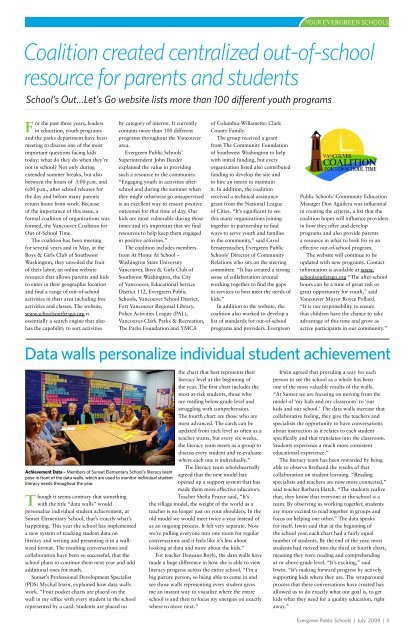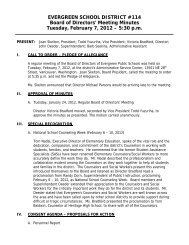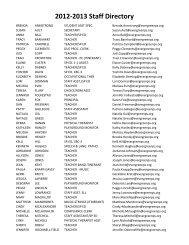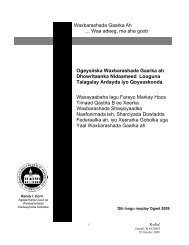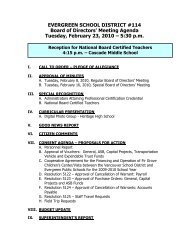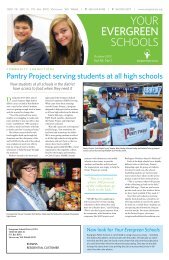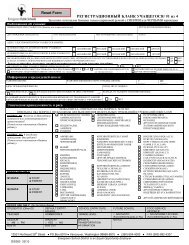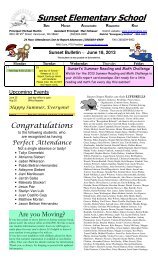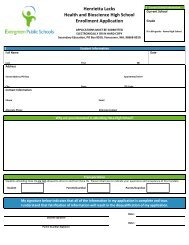Your EVERgREEN SchoolS - Evergreen Public Schools
Your EVERgREEN SchoolS - Evergreen Public Schools
Your EVERgREEN SchoolS - Evergreen Public Schools
Create successful ePaper yourself
Turn your PDF publications into a flip-book with our unique Google optimized e-Paper software.
<strong>Your</strong> <strong>Evergreen</strong> <strong>Schools</strong><br />
Coalition created centralized out-of-school<br />
resource for parents and students<br />
School’s Out…Let’s Go website lists more than 100 different youth programs<br />
For the past three years, leaders<br />
in education, youth programs<br />
and the parks department have been<br />
meeting to discuss one of the most<br />
important questions facing kids<br />
today: what do they do when they’re<br />
not in school Not only during<br />
extended summer breaks, but also<br />
between the hours of 3:00 p.m. and<br />
6:00 p.m., after school releases for<br />
the day and before many parents<br />
return home from work. Because<br />
of the importance of this issue, a<br />
formal coalition of organizations was<br />
formed, the Vancouver Coalition for<br />
Out-of-School Time.<br />
The coalition has been meeting<br />
for several years and in May, at the<br />
Boys & Girls Club of Southwest<br />
Washington, they unveiled the fruit<br />
of their labor, an online website<br />
resource that allows parents and kids<br />
to enter in their geographic location<br />
and find a range of out-of-school<br />
activities in their area including free<br />
activities and classes. The website,<br />
www.schoolsoutletsgo.org is<br />
essentially a search engine that also<br />
has the capability to sort activities<br />
by category of interest. It currently<br />
contains more than 100 different<br />
programs throughout the Vancouver<br />
area.<br />
<strong>Evergreen</strong> <strong>Public</strong> <strong>Schools</strong>’<br />
Superintendent John Deeder<br />
explained the value in providing<br />
such a resource to the community.<br />
“Engaging youth in activities afterschool<br />
and during the summer when<br />
they might otherwise go unsupervised<br />
is an excellent way to ensure positive<br />
outcomes for that time of day. Our<br />
kids are most vulnerable during those<br />
times and it’s important that we find<br />
resources to help keep them engaged<br />
in positive activities.”<br />
The coalition includes members<br />
from At Home At School –<br />
Washington State University<br />
Vancouver, Boys & Girls Club of<br />
Southwest Washington, the City<br />
of Vancouver, Educational Service<br />
District 112, <strong>Evergreen</strong> <strong>Public</strong><br />
<strong>Schools</strong>, Vancouver School District,<br />
Fort Vancouver Regional Library,<br />
Police Activities League (PAL),<br />
Vancouver-Clark Parks & Recreation,<br />
The Parks Foundation and YMCA<br />
of Columbia-Willamette: Clark<br />
County Family.<br />
The group received a grant<br />
from The Community Foundation<br />
of Southwest Washington to help<br />
with initial funding, but every<br />
organization listed also contributed<br />
funding to develop the site and<br />
to hire an intern to maintain<br />
it. In addition, the coalition<br />
received a technical assistance<br />
grant from the National League<br />
of Cities. “It’s significant to see<br />
this many organizations joining<br />
together in partnership to find<br />
ways to serve youth and families<br />
in the community,” said Carol<br />
Fenstermacher, <strong>Evergreen</strong> <strong>Public</strong><br />
<strong>Schools</strong>’ Director of Community<br />
Relations who sits on the steering<br />
committee. “It has created a strong<br />
sense of collaboration around<br />
working together to find the gaps<br />
in services to best meet the needs of<br />
kids.”<br />
In addition to the website, the<br />
coalition also worked to develop a<br />
list of standards for out-of-school<br />
programs and providers. <strong>Evergreen</strong><br />
<strong>Public</strong> <strong>Schools</strong>’ Community Education<br />
Manager Don Aguilera was influential<br />
in creating the criteria, a list that the<br />
coalition hopes will influence providers<br />
in how they offer and develop<br />
programs and also provide parents<br />
a resource in what to look for in an<br />
effective out-of-school program.<br />
The website will continue to be<br />
updated with new programs. Contact<br />
information is available at www.<br />
schoolsoutletsgo.org “The after-school<br />
hours can be a time of great risk or<br />
great opportunity for youth,” said<br />
Vancouver Mayor Royce Pollard.<br />
“It is our responsibility to ensure<br />
that children have the chance to take<br />
advantage of this time and grow as<br />
active participants in our community.”<br />
Data walls personalize individual student achievement<br />
Achievement Data – Members of Sunset Elementary School’s literacy team<br />
pose in front of the data walls, which are used to monitor individual student<br />
literacy needs throughout the year.<br />
Though it seems contrary that something<br />
with the title “data walls” would<br />
personalize individual student achievement, at<br />
Sunset Elementary School, that’s exactly what’s<br />
happening. This year the school has implemented<br />
a new system of tracking student data on<br />
literacy and writing and presenting it in a wallsized<br />
format. The resulting conversations and<br />
collaboration have been so successful, that the<br />
school plans to continue them next year and add<br />
additional ones for math.<br />
Sunset’s Professional Development Specialist<br />
(PDS) Mychal Irwin, explained how data walls<br />
work. “Four pocket charts are placed on the<br />
wall in my office with every student in the school<br />
represented by a card. Students are placed on<br />
the chart that best represents their<br />
literacy level at the beginning of<br />
the year. The first chart includes the<br />
most at-risk students, those who<br />
are reading below grade level and<br />
struggling with comprehension.<br />
The fourth chart are those who are<br />
most advanced. The cards can be<br />
updated from each level as often as a<br />
teacher wants, but every six weeks,<br />
the literacy team meets as a group to<br />
discuss every student and re-evaluate<br />
where each one is individually.”<br />
The literacy team wholeheartedly<br />
agreed that the new model has<br />
opened up a support system that has<br />
made them more effective educators.<br />
Teacher Sheila Pearce said, “It’s<br />
the village model, the weight of the world as a<br />
teacher is no longer just on your shoulders. In the<br />
old model we would meet twice a year instead of<br />
as an ongoing process. It felt very separate. Now<br />
we’re pulling everyone into one room for regular<br />
conversations and it feels like it’s less about<br />
looking at data and more about the kids.”<br />
For teacher Deneane Boyle, the data walls have<br />
made a huge difference in how she is able to view<br />
literacy progress across the entire school. “I’m a<br />
big picture person, so being able to come in and<br />
see those walls representing every student gives<br />
me an instant way to visualize where the entire<br />
school is and then to focus my energies on exactly<br />
where to move next.”<br />
Irwin agreed that providing a way for each<br />
person to see the school as a whole has been<br />
one of the most valuable results of the walls.<br />
“At Sunset we are focusing on moving from the<br />
model of ‘my kids and my classroom’ to ‘our<br />
kids and our school.’ The data walls increase that<br />
collaborative feeling, they give the teachers and<br />
specialists the opportunity to have conversations<br />
about instruction as it relates to each student<br />
specifically and that translates into the classroom.<br />
Students experience a much more consistent<br />
educational experience.”<br />
The literacy team has been rewarded by being<br />
able to observe firsthand the results of that<br />
collaboration on student learning. “Reading<br />
specialists and teachers are now more connected,”<br />
said teacher Barbara Hatch. “The students realize<br />
that, they know that everyone at the school is a<br />
team. By observing us working together, students<br />
are more excited to read together in groups and<br />
focus on helping one other.” The data speaks<br />
for itself. Irwin said that at the beginning of<br />
the school year, each chart had a fairly equal<br />
number of students. By the end of the year, most<br />
students had moved into the third or fourth chart,<br />
meaning they were reading and comprehending<br />
at or above grade level. “It’s exciting,” said<br />
Irwin. “It’s making forward progress by actively<br />
supporting kids where they are. The wraparound<br />
process that these conversations have created has<br />
allowed us to do exactly what our goal is, to get<br />
kids what they need for a quality education, right<br />
away.”<br />
<strong>Evergreen</strong> <strong>Public</strong> <strong>Schools</strong> | July 2009 | 3


